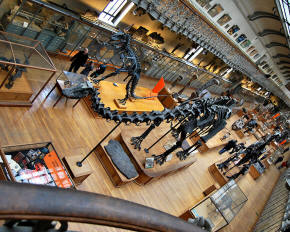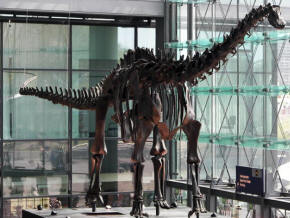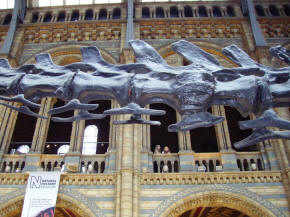|
It lived in what is now western
North America at the end of the Jurassic Period.
Diplodocus is one
of the more common dinosaur fossils found in the Upper
Morrison Formation, a
sequence of shallow marine and alluvial sediments deposited about 155 to 148
million years ago, in what is now termed the
Kimmeridgian and
Tithonian
stages (Diplodocus
itself ranged from about 154-150 million years ago). The Morrison Formation
records an environment and time dominated by gigantic sauropod dinosaurs
such as
Camarasaurus,
Barosaurus,
Apatosaurus and
Brachiosaurus.
Diplodocus
is among the most easily identifiable dinosaurs, with its classic dinosaur
shape, long neck and tail and four sturdy legs. For many years, it was the
longest dinosaur known. Its great size may have been a deterrent to the
predators
Allosaurus and
Ceratosaurus: their remains have been found
in the same
strata, which suggests
they coexisted with Diplodocus.
Description
One of the best-known sauropods,
Diplodocus was a
very large long-necked quadrupedal animal, with a long, whip-like tail. Its
forelimbs were slightly shorter than its hind limbs, resulting in a largely
horizontal posture. The long-necked, long-tailed animal with four sturdy
legs has been mechanically compared with a suspension bridge. In fact,
Diplodocus is the
longest dinosaur known from a complete skeleton.
The partial remains of D. hallorum
have increased the estimated length, though not as much as previously
thought; when first described in 1991, discoverer David Gillette calculated
it may have been up to 54 m (177 ft) long, making it the longest known
dinosaur (excluding those known from especially poor remains, such as
Amphicoelias). Some weight estimates ranged
as high as 113 (rather only 50)
tonnes (125 US short
tons). This review was based on recent findings that show that the giant
tail vertebrae were actually placed further forward on the tail than
Gillette originally calculated. The study shows that the complete
Diplodocus skeleton at the
Carnegie Museum of Natural History
in Pittsburgh, Pennsylvania, on which estimates of
Seismosaurus were based,
had its 13th tail vertebra come from another dinosaur, throwing size
estimates for Seismosaurus
off by up to 30%. While dinosaurs such as
Supersaurus were probably longer, fossil
remains of these animals are only fragmentary. Modern mass estimates for
Diplodocus
(exclusive of D. hallorum)
have tended to be in the 10 to 16 tonne (11–17.6 ton)
range: 10 tonnes (11 tons); 11.5 tonnes (12.7 tons); 12.7 tonnes (14 tons);
and 16 tonnes (17.6 tons).
The skull of
Diplodocus was very small,
compared with the size of the animal, which could reach up to 35 m (115 ft),
of which over 6 m (20 ft) was neck. Diplodocus
had small, 'peg'-like teeth that pointed forward and were only present in
the
anterior sections of
the jaws. Its braincase was small. The neck was composed of at least fifteen
vertebrae and is now believed to have been generally held parallel to the
ground and unable to have been elevated much past horizontal.
Diplodocus
had an extremely long tail, composed of about 80 caudal vertebrae, which is almost double the number some of the earlier sauropods had in their tails
(such as
Shunosaurus with 43),
and far more than contemporaneous
macronarians had (such
as
Camarasaurus with 53).
There has been speculation as to whether it may have had a defensive or
noisemaking (by cracking it like a
coachwhip) function. The tail may have
served as a counterbalance for the neck. The middle part of the tail had
'double beams' (oddly shaped bones on the underside, which gave
Diplodocus its name). They
may have provided support for the vertebrae, or perhaps prevented the blood
vessels from being crushed if the animal's heavy tail pressed against the
ground. These 'double beams' are also seen in some related dinosaurs.
Like other sauropods, the manus
(front "feet") of Diplodocus
were highly modified, with the finger and hand bones arranged into a
vertical column, horseshoe-shaped in cross section.
Diplodocus lacked claws on
all but one digit of the front limb, and this claw was unusually large
relative to other sauropods, flattened from side to side, and detached from
the bones of the hand. The function of this unusually specialized claw is
unknown.
Discovery
and species
Several species of
Diplodocus were described
between 1878 and 1924. The first skeleton was found at Cañon City, Colorado
by
Benjamin Mudge and
Samuel Wendell Williston
in 1877, and was named Diplodocus longus
('long double-beam'), by paleontologist
Othniel Charles Marsh
in 1878. Diplodocus
remains have since been found in the
Morrison
 |
| Holland's D. carnegii replica in the Paris Musée
d'histoire naturelle, much as it was in 1908. (Picture
Source) |
Formation of
the western U.S. States of Colorado, Utah, Montana and Wyoming. Fossils of
this animal are common, except for the skull, which is often missing from
otherwise complete skeletons. Although not the type species,
D. carnegii is the most
completely known and most famous due to the large number of casts of its
skeleton in museums around the world.
The two Morrison Formation sauropod
genera Diplodocus
and Barosaurus had
very similar limb bones. In the past, many isolated limb bones were
automatically attributed to Diplodocus
but may, in fact, have belonged to Barosaurus.
Fossil remains of Diplodocus
have been recovered from stratigraphic zone 5 of the Morrison Formation.
Return to the
Old Earth Ministries Online Dinosaur
Curriculum homepage.

Shopping
Bay
State Replicas - None
Black
Hills Institute - None
|



